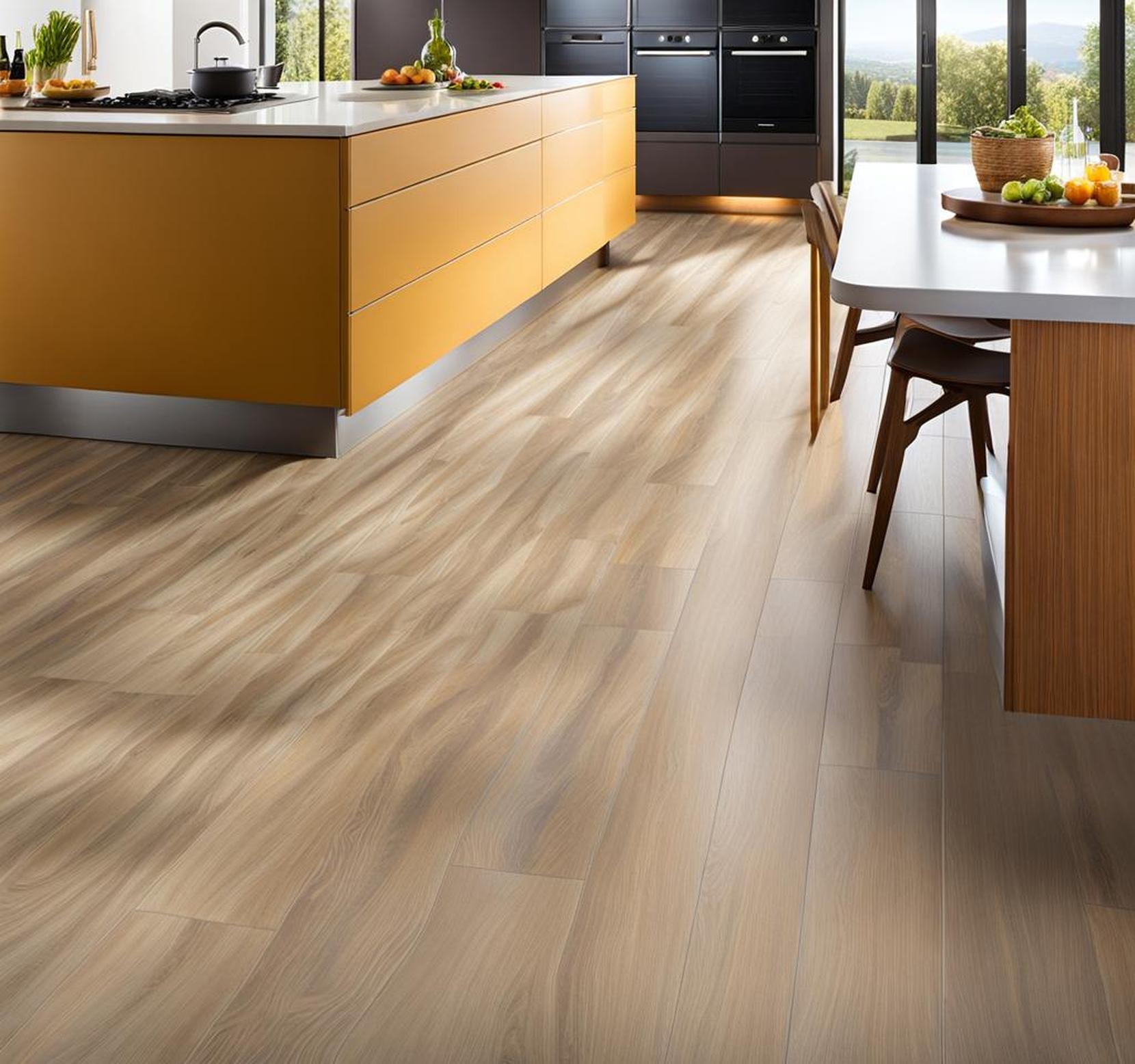With its affordability and style options, vinyl flooring can be a great choice for kitchens. Vinyl offers the look of pricier materials like ceramic tile or hardwood but without the higher cost. Read on to learn why vinyl deserves serious consideration for your next kitchen flooring project.
Vinyl has come a long way from the dated sheet floors found in older homes. Today’s vinyl includes stylish luxury vinyl planks with realistic wood and stone looks. Modern patterns like bold geometric designs and concrete effects take vinyl far beyond the blah, basic options of yesterday.
Durability of Vinyl Flooring
One of the biggest benefits of vinyl flooring is its durability. Made from resilient synthetic materials and topped with a clear wear layer, vinyl stands up to heavy usage and resists scratches, gouges, dents, stains and moisture.
Quality vinyl flooring should last anywhere from 10-20 years in the kitchen when properly cared for. The top protective layer shields against damage from dropped pots, pans, appliances and other kitchen items that put floors to the test. Vinyl won’t easily stain from food spills and splatters either. Its non-porous surface allows for easy wiping and cleaning.
Luxury Vinyl Plank Flooring
For even greater durability, consider luxury vinyl plank (LVP) flooring. LVP offers a layered construction that makes it more impervious to damage. The layers provide cushioning underfoot while protecting the vinyl wear layer on top.
With proper maintenance, LVP floors can last 15-25 years looking great. The planks resist scratches, gouges and moisture thanks to their durable and waterproof construction. LVP brings you exceptional resilience without a high price tag.
Vinyl Sheet Flooring
Vinyl sheet flooring is another budget-friendly option for kitchens. Seamless vinyl sheets provide an affordable, easy-to-clean surface that holds up well to heavy use. Though durable, vinyl sheet isn’t quite as resilient as luxury vinyl planking.

The main downside is visible seams that can collect dirt and moisture over time. Gouges and tears in the surface are also harder to repair. But with proper installation and care vinyl sheet can be a solid performer in kitchens needing an inexpensive flooring solution.
Waterproof Qualities
Vinyl flooring’s waterproof construction gives it superior performance in kitchens. Food preparation, cooking, cleaning and unpredictable spills make kitchen floors susceptible to moisture. Vinyl provides complete liquid resistance.
All vinyl floors are designed as fully waterproof. Liquids simply wipe away without being absorbed into the flooring. This prevents warping, shrinking or cracking over time. Vinyl flooring can shrug off spills, flooding mishaps and high humidity.
The waterproof qualities also make vinyl great for kitchen backsplashes. Use colorful vinyl tiles or sheets to create a washable, moisture-proof wall covering behind sinks and prep areas.
Affordability of Vinyl Floors
One of the biggest perks of vinyl flooring is affordability. Vinyl costs significantly less than upscale materials like hardwood, natural stone, or ceramic tile. It enables budget-friendly kitchen updates.
Standard vinyl tiles or sheets start around $2-4 per square foot installed. Luxury vinyl plank flooring runs $3-7 per square foot installed. Either option costs a fraction of materials like hardwood ($6-15 per square foot), ceramic tile ($10-20 per square foot), or natural stone ($25-50+ per square foot).
The lower cost makes vinyl a smart choice for rental properties, vacation homes, or spaces where a premium floor isn’t needed. You can get the visual appeal of pricier floors without breaking the bank.
Low Maintenance Needs
Easy maintenance is another vinyl flooring advantage. Keeping vinyl looking good doesn’t require special cleaners or a rigorous upkeep routine.
Vinyl resists most dirt, stains, and spills with simple sweeping, mopping or wiping. Warm water and gentle cleansers like dish soap or vinegar take care of most messes. For tougher jobs, all-purpose cleaners or diluted bleach give extra cleaning power.
Unlike wood floors, vinyl won’t need refinishing or re-coating every few years either. And there’s no waxing required to maintain shine and luster. Just regular light mopping and sweeping keeps vinyl floors looking their best in kitchens.
Design and Style Options
Vinyl flooring offers almost endless possibilities to fit your kitchen decor. Choose from patterns like geometric tiles, whitewashed wood planks, or checkerboard designs. Unleash your creativity!
Realistic wood looks dominate vinyl plank flooring trends. Get the warmth and character of hardwood for a fraction of the price. Gray washed oak, weathered barnwood, and rustic hickory patterns recreate coveted hardwood aesthetics.
Natural stone visuals like marble, travertine and slate are equally trending. Porcelain-look tiles give a cool, crisp modern vibe. Concrete effects bring industrial edge, especially with bold grey and black hues.
Don’t overlook fun colors and prints as well. Cheerful florals, energetic zigzags, and retro geometric patterns add lively personality. And vibrant shades like teal, yellow and berry punk up neutral palettes.
Choosing Vinyl Flooring for Your Kitchen
When selecting vinyl flooring, first consider your kitchen’s needs and lifestyle factors. Active families may want more durable planks, while empty nesters can opt for budget sheet vinyl.
Measure your space carefully to purchase adequate flooring with a 5-10% overage for cutoffs. For sheet vinyl, minimize seams by limiting required cuts.
Hiring a professional installer is wise to ensure proper subfloor prep and installation. This gives your vinyl flooring the longest life.
Follow manufacturer’s care guidelines as well for cleaning, avoiding scratches and maintaining warranty coverage. With proper vinyl flooring choices and care, your kitchen can stay beautiful for years.
Vinyl deserves serious consideration as a smart, stylish flooring solution for kitchens. Thanks to its durability, waterproof qualities, affordability, and vast design options, vinyl can handle the demands of a busy kitchen.
Modern vinyl styles like luxury vinyl planks realistically mimic wood and stone for a fraction of their cost. Vibrant colors, fun patterns, and cool concrete effects take vinyl beyond basic to stylish. For coastal properties, second homes and budget-friendly remodels, vinyl flooring earns top marks.
You can install vinyl flooring in your kitchen for many years. Consider vinyl alongside more traditional options like ceramic tile or oak hardwood when planning your next kitchen project.
